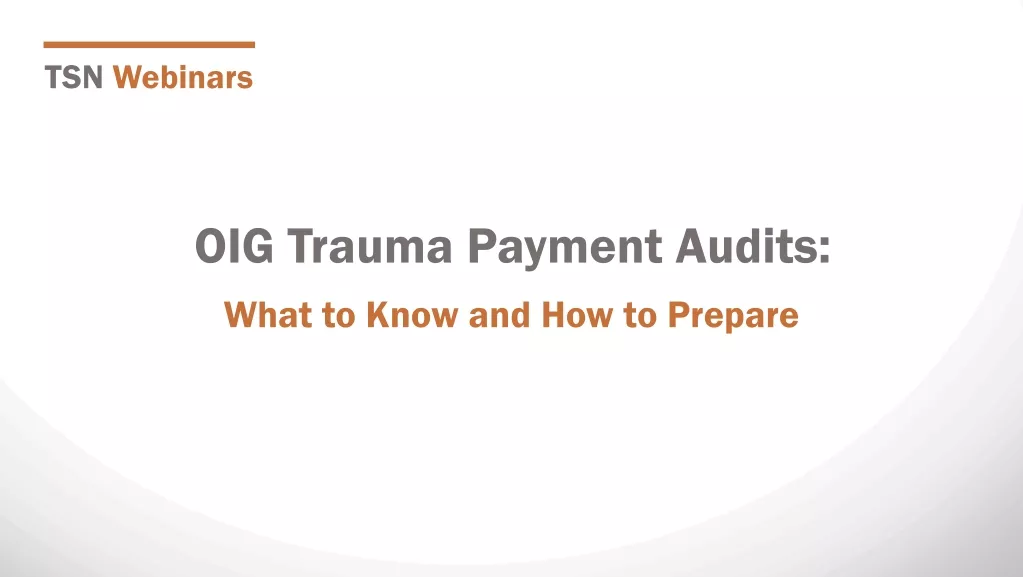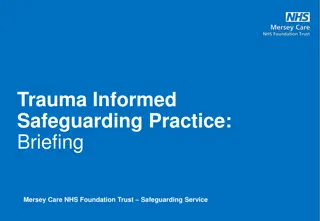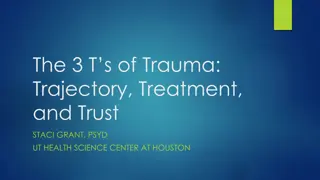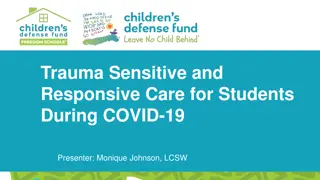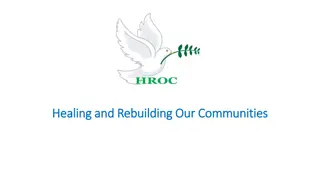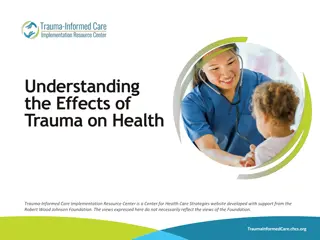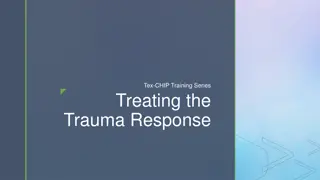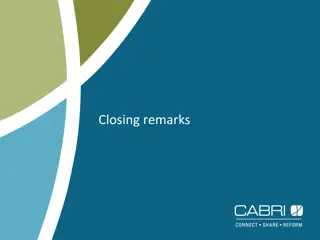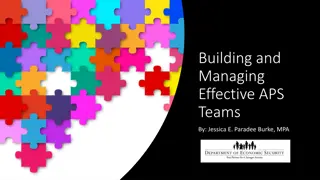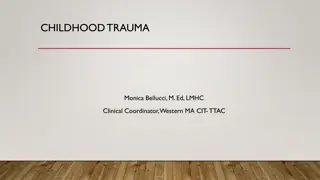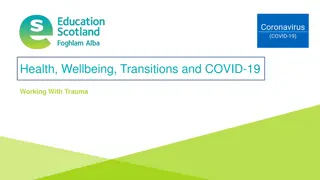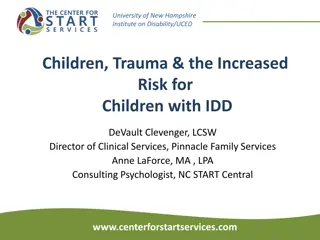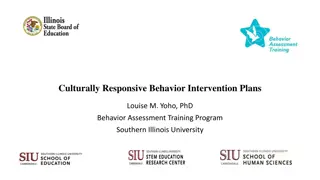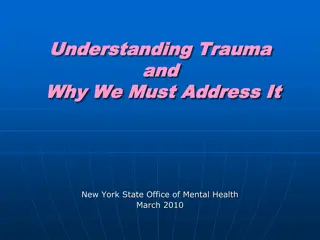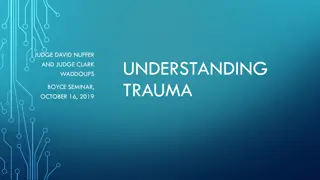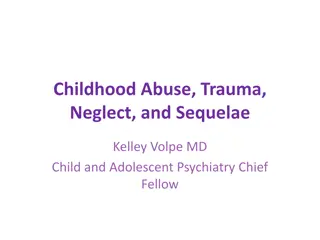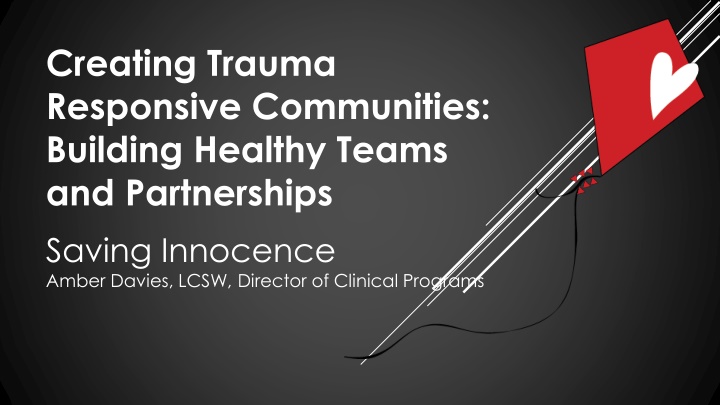
Building Trauma-Responsive Communities and Empowering Survivors
This informative content delves into creating trauma-responsive communities, empowering survivors, and providing valuable insights on trauma-informed care, healthy teams, and effective partnerships. It emphasizes principles like safety, trustworthiness, collaboration, and empowerment while offering practical guidance on first contact, helping trauma survivors, and raising awareness about PTSD. The Strengths-Based Empowerment Model and the importance of being trauma-informed and trauma-responsive are highlighted, underscoring the significance of support, understanding, and positive experiences in healing trauma.
Download Presentation

Please find below an Image/Link to download the presentation.
The content on the website is provided AS IS for your information and personal use only. It may not be sold, licensed, or shared on other websites without obtaining consent from the author. If you encounter any issues during the download, it is possible that the publisher has removed the file from their server.
You are allowed to download the files provided on this website for personal or commercial use, subject to the condition that they are used lawfully. All files are the property of their respective owners.
The content on the website is provided AS IS for your information and personal use only. It may not be sold, licensed, or shared on other websites without obtaining consent from the author.
E N D
Presentation Transcript
Creating Trauma Responsive Communities: Building Healthy Teams and Partnerships Saving Innocence Amber Davies, LCSW, Director of Clinical Programs
UBUNTU I am because we are.
PRINCIPLES OF TRAUMA INFORMED CARE 1. Safety 2. Trustworthiness and transparency 3. Peer support and mutual self-help 4. Collaboration and mutuality 5. Empowerment, voice, and choice 6. Cultural, historical, and gender issues
ADDING VALUE - Valuing others - Principles of leadership - Make yourselves more valuable - Opening doors, making introductions - Know and relate to what others value - Listen then lead
STRENGTHS BASED EMPOWERMENT MODEL Self-determination vs. Safety Jumping out of the car vs. returning to police station Returning to trafficker vs. returning to placement
TRAUMA INFORMED AND TRAUMA RESPONSIVE The way we think What we feel The way we communicate The way we practice
FIRST CONTACT AND FIRST IMPRESSIONS Fighting instincts You control how it goes with first conversation Stay calm and be genuine Ask about basic needs Have a poker face, minor may disclose information Kids like to know your motivation
HELPING TRAUMA SURVIVORS Answer some of their questions about what they may be experiencing Normalize their distress by letting them know that what they are experiencing is normal Help them to learn effective coping strategies
Help them to be aware of possible symptoms that may require additional assistance Give them a positive experience that will increase their chances of seeking help in the future PTSD and what we go home to
https://www.ted.com/talks/johann_hari_everything_you_think_youhttps://www.ted.com/talks/johann_hari_everything_you_think_you _know_about_addiction_is_wrong THE OPPOSITE OF ADDICTION IS CONNECTION. - JOHANN HARI - Social Recovery - You are not alone. -
1. Have a non-judgemental attitude 2. Emphasize the person s ability to care for himself or herself 3. Use short-term pragmatic goals and a scale of behaviors to achieve the goals 4. Provide information about health and risk behaviors Harm Reduction
5. Focus on concrete risk behaviors and connect those with the individual s reality (his/her own risk behaviors) 6. Provide different options to reduce the risks 7. Provide a supportive environment (professionals, family, peers, etc.) 8. Have a team of experienced professionals involved in designing and implementing harm reduction strategies. Harm Reduction
SAFETY & PLANNING Physical Safety Emotional Safety Safety Plan Procedures Needed Partnerships Relationships
Minimize risk of making things worse Maximize possibility of improvement Leadership training and development Skills for teamwork Cross collaboration System integration MODELING creating and modeling healthy and supportive relationships between individuals, and developing an atmosphere of hope and non-violence. - The Sanctuary Model, Dr. Sandra Bloom
CREATIVE SOLUTIONS Connecting youth to other services Ensuring safety of youth and self Knowing your kids Knowing your partners Reinforcing goals Survivor Lead Initiatives
SURVIVOR LEADERSHIP Engaging survivors Recovery model Creating and maintaining boundaries Requirements
Relationship Directed Advocacy Pursuit of child Need for Community vs. Need for Services Self Directed goals - reciprocity/ expectations Community connections Permanency in child s life
Healthiest and Most Adaptive Approaches Applying Zone of Control: We can accept it We can change it We can change the way we deal with it We can escape it. - - - - (From Building Resilient Teams, Fisher, P.) -
SELF CARE Practice and model it! Supervision Low Impact Debriefing Taking time Coping skills Solid Support system/ work environment
SELF CARE IN AGENCIES Essential for leadership to buy into needs Additional time off (vacation) Bookending time off around time intensive and emotionally intensive events i.e. sting operations, trials, crisis calls, death of a client, etc. Making supervision / processing / debriefing available after strenuous events Monthly activities and team building Professional development Annual Rejuvenation Week
Contact: AMBER@SAVINGINNOCENCE.ORG @savinginnocence

